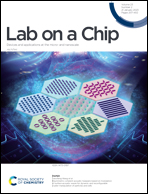Bending Drosophila larva using a microfluidic device enables imaging of its brain and nervous system at single neuronal resolution†
Abstract
Single neuronal imaging of a fully intact Drosophila larva is a difficult challenge for neurosciences due to the robust digging/burrowing behaviour of the Drosophila larva and the lack of intact immobilization methods at single-neuron resolution. In this paper, for the first time, a simple microfluidic device to completely immobilize the brain and the CNS of a live, fully-functioning Drosophila larva for single neuronal imaging has been demonstrated. The design of the microfluidic device contains a unique clamping feature which pins and bends the body of the larva at 1/3rd of its length from the head. This simple twist combined with the pinning mechanism not only could stop the locomotion of the larva but also could immobilize the major movement of internal organs including the CNS. The results showed that the bent trap could keep the single neuron completely inside the field of view (FOV) (50 μm × 50 μm) over 10 min of confocal imaging. The range of motion in the x- and y-axis was approximately 8 μm and 2.5 μm, respectively. This corresponds to a range of 16% and 6% along the axis of the channel and across it compared to the size of the FOV (50 μm × 50 μm). The calcium activity of the single neurons in a 3rd instar GCaMP5 larva (Cha-Gal4/CyO; UAS-GCaMP5G/TM3) was measured while its mouth region was exposed to 20 mM sodium azide (NaN3) for 5 s. The results showed that the activity of the neurons has been statistically (p < 0.0005) increased (∼60%).



 Please wait while we load your content...
Please wait while we load your content...